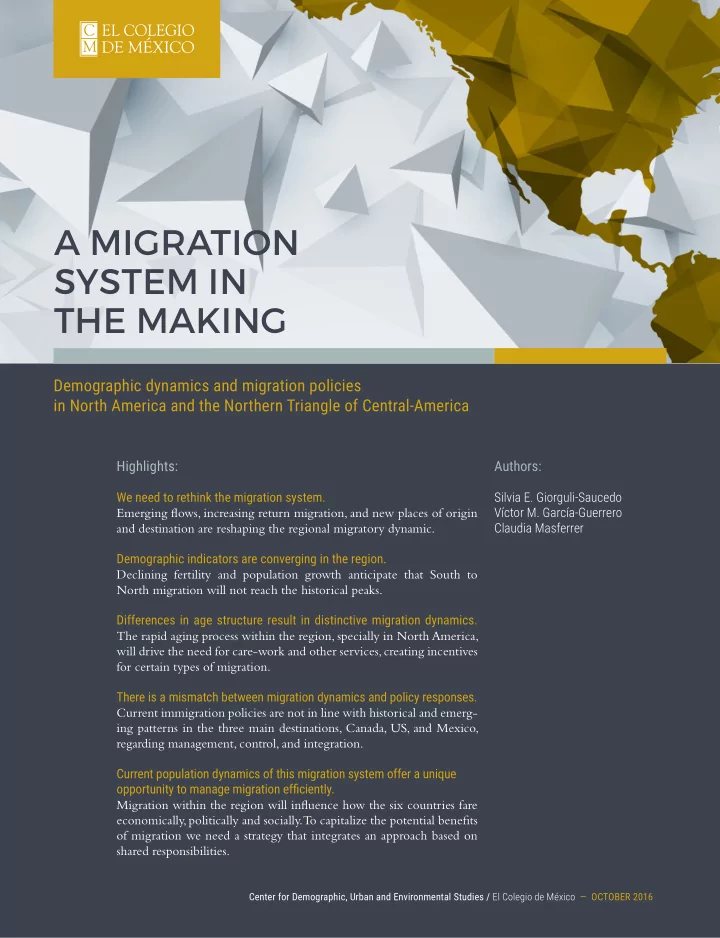

A MIGRATION SYSTEM IN THE MAKING Demographic dynamics and migration policies in North America and the Northern Triangle of Central-America Highlights: Authors: We need to rethink the migration system. Silvia E. Giorguli-Saucedo Víctor M. García-Guerrero Emerging fmows, increasing return migration, and new places of origin Claudia Masferrer and destination are reshaping the regional migratory dynamic. Demographic indicators are converging in the region. Declining fertility and population growth anticipate that South to North migration will not reach the historical peaks. Differences in age structure result in distinctive migration dynamics. The rapid aging process within the region, specially in North America, will drive the need for care-work and other services, creating incentives for certain types of migration. There is a mismatch between migration dynamics and policy responses. Current immigration policies are not in line with historical and emerg- ing patterns in the three main destinations, Canada, US, and Mexico, regarding management, control, and integration. Current population dynamics of this migration system offer a unique opportunity to manage migration effjciently. Migration within the region will infmuence how the six countries fare economically, politically and socially. T o capitalize the potential benefjts of migration we need a strategy that integrates an approach based on shared responsibilities. Center for Demographic, Urban and Environmental Studies / El Colegio de México — OCTOBER 2016
A MIGRATION SYSTEM IN THE MAKING Demographic dynamics and migration policies in North America and the Northern Triangle of Central-America 1. RETHINKING THE MIGRATION SYSTEM. within the region has also changed. Migration for family reasons persists within this fmow while the Since the last century, the three countries in North Amer- number of migrants with temporary working visas ica (Canada, the United States and Mexico) and the three in the main destinations has increased. 6. A large, unauthorized population in the United in the Northern Triangle of Central America (Guatemala, El Salvador and Honduras) have experienced large human States is the result of historical migration patterns. mobility within the region. The sustained, multi-directional However, this is not the case in Canada or Mexico. nature of the fmows, together with other economic and cul- tural ties, have created a migratory system. These changes within the migratory system are re- Traditionally dominated by South-North migration, lated to the socioeconomic and demographic dynamics with the US and Canada as the main destinations, this mi- in the sending and receiving countries and the migration gration system is now more complex as it includes new policies in the three main destinations. Emerging trends fmows, places of origin and destinations. A brief overview are mixed, with longer lasting processes, such as the for- of the current movements is given below: mation of large communities of foreign-born population in the main destinations (Table 1), which have remained 1. A sharp drop in migration from Mexico to the US connected to their sending contexts in difgerent ways. since 2007; fmows have remained at a historically Geographical proximity coupled with sustained historical, low level. cultural and social ties within the region are some of the 2. An increase in North-South fmows, which includes reasons why the migration system remains dynamic and approximately one million US-born persons who multi-directional. have mainly moved to Mexico. A key point in the general discussion of the future 3. The emergence of Mexico as a place of destination of the six countries analyzed in this paper is the role in- for US and Central American outmigration. ternational migration may play within each context. To 4. Socioeconomic transformations in traditional plac- what extent can we expect migration fmows between and es of origin are underway and will continue. This within North America and the NTCA to be sustained trend may translate into changes in the composi- in the short term and what changes in migrants’ profjle tion of the fmows. Participation in the migration will we see in the future? Are national migration policies fmows of urban population with higher educational responding to this emerging scenario? What political re- attainment from Mexico and the Northern Trian- sponses do we need to manage migration effjciently and gle of Central America (NTCA) has increased. capitalize the potential benefjts of international migra- 5. Traditionally thought of as labor-driven migration tion? The following sections of this paper focus on the with a large undocumented component, mobility fjrst two questions. Table 1. Total and foreign-born population in North America and the Northern Triangle of Central America Total foreing-born population Percentage of total Total population (thousands) % Change (thousands) pop. Country 2000 2013 2000 2013 2000 2013 (2000-2013) Canada 30,697.4 35,181.7 5,555.0 7,284.1 18.1 20.7 31.1 US 284,594.4 320,050.7 34,814.1 45,785.1 12.2 14.3 31.5 Mexico 103,873.6 122,332.4 520.7 1,103.5 0.5 0.9 111.9 Guatemala 11,204.2 15,468.2 48.1 72.8 0.4 0.5 51.2 El Salvador 5,958.8 6,340.5 31.7 41.6 0.5 0.7 31.2 Honduras 6,235.6 8,097.7 28.5 27.5 0.5 0.3 -3.4 Source: United Nations, Department of Economic and Social Affairs, Population Division (2013). World Populations Prospects: The 2012 Revision. 2 OCTOBER 2016 — Center for Demographic, Urban and Environmental Studies / El Colegio de México
Recommend
More recommend